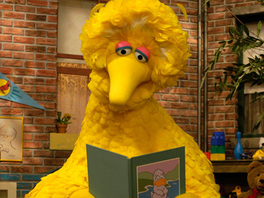 It seems hard to believe, but Sesame Street just celebrated its 40th year on the air. I celebrated the show’s birthday by attending a panel discussion on “40 Years of Life on the Street” at the Brooklyn Public Library on November 21. The panel was moderated by Louise A. Gikow, a Sesame Street writer, former editorial director at Jim Henson Productions, and author of Sesame Street: A Celebration of 40 Years of Life on the Street, and featured Bob McGrath, one of the original cast members on the show, where he plays a music teacher who lives in an apartment over Hooper’s Store; Fran Brill, the first female muppet performer on the show, who created the muppet characters Prairie Dawn and Zoe; Chris Cerf, the songwriter behind tunes like “Letter B” and “Put Down the Duckie”; Carol-Lynn Parente, the show’s Executive Producer; and Rollie Krewson, one of the top puppet designers and builders at the Jim Henson Company, who designed and built Sesame Street muppet characters Zoe, Abby Cadabby, and Murray Monster.
It seems hard to believe, but Sesame Street just celebrated its 40th year on the air. I celebrated the show’s birthday by attending a panel discussion on “40 Years of Life on the Street” at the Brooklyn Public Library on November 21. The panel was moderated by Louise A. Gikow, a Sesame Street writer, former editorial director at Jim Henson Productions, and author of Sesame Street: A Celebration of 40 Years of Life on the Street, and featured Bob McGrath, one of the original cast members on the show, where he plays a music teacher who lives in an apartment over Hooper’s Store; Fran Brill, the first female muppet performer on the show, who created the muppet characters Prairie Dawn and Zoe; Chris Cerf, the songwriter behind tunes like “Letter B” and “Put Down the Duckie”; Carol-Lynn Parente, the show’s Executive Producer; and Rollie Krewson, one of the top puppet designers and builders at the Jim Henson Company, who designed and built Sesame Street muppet characters Zoe, Abby Cadabby, and Murray Monster.
What can I say about Sesame Street that hasn’t been said already? Seen around the world for decades by millions of children, Sesame Street is still the preeminent show for preschoolers and the gold standard by which other kids’ shows are inevitably judged. As head of research for Sesame Street in the mid-90’s, I know a lot about what makes Sesame Street so special, but the panel discussion at the Brooklyn Public Library helped to bring the show’s unique features into focus.
Sesame Street started out as an experiment in a new kind of educational television for preschool-age children. From its inception, each episode of the show has been written and produced to achieve specific curriculum goals, and intensive research is conducted to help each show achieve those goals and to measure whether the goals are being met. At the same time, each episode of the show is also written to grab and hold the young audience’s attention by entertaining them with amazingly clever and sophisticated comedy, graphics, and music, multi-dimensional puppet and human characters, and engaging plots.
As the panelists explained, Sesame Street writers were recruited from the Harvard Lampoon, comedy shows and clubs, and Broadway. Traditional children’s literature writers were not welcome. Consequently, each show has multiple levels of humor and wit that delight adult viewers as much as the kids. The three-year-old viewer may not know or care that “Letter B” is a hilarious riff on the Beatles’ “Let it Be,” but he or she can still enjoy the song on its own terms.
Sesame Street was certainly influenced by earlier kids’ shows, but it added a level of contemporary wit, edge, and intelligence, all in the service of predefined and explicit educational goals that resulted in a transformative new kind of kids show. We can all be grateful that Sesame Street has continued to renew and reinvent itself for successive generations of children and parents around the globe.
In honor of Sesame Street’s 40th anniversary, there is a special DVD compilation available — Sesame Street: 40 Years of Sunny Days, a commemorative collection with over 5 hours of iconic moments, favorite songs, celebrity segments and exclusive backstage footage. There’s also a wonderful new book about the show’s history, Sesame Street: A Celebration of 40 Years of Life on the Street, which provides an insider’s view of all of the Muppet and human characters, as well as the writers, directors, producers, and other creative people who have made learning fun for generations of kids.


Recent Comments